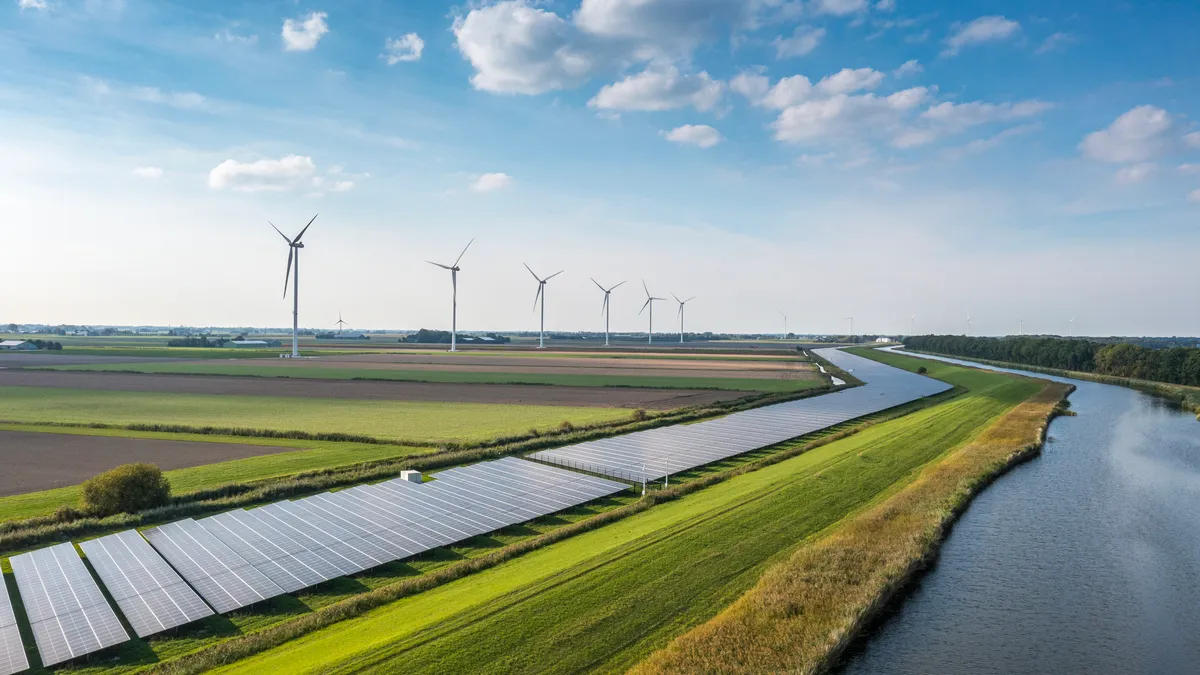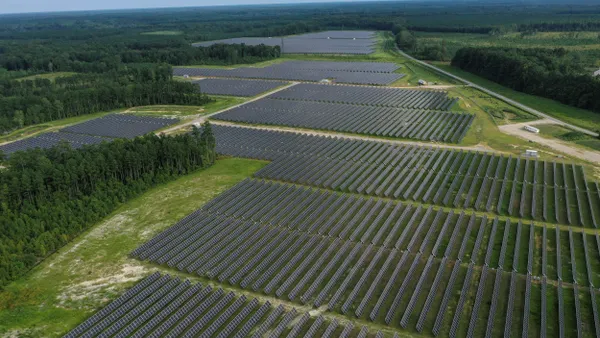Dive Brief:
- Average levelized costs of energy for new U.S. wind and solar projects showed little change from 2023 to 2024 but have increased significantly since 2021 due to higher interest rates and other cost pressures, according to a report released this month by Lazard.
- Lazard’s June 2024 Levelized Cost of Energy+ report found that the LCOE for standalone onshore wind increased from $38/MWh in 2021 to $50/MWh in 2023 and 2024, while the LCOE for standalone utility-scale solar PV increased from $36/MWh in 2021 to $60/MWh in 2023 and $61/MWh in 2024. The LCOE for combined-cycle gas turbine power — the next-cheapest generation source examined in the report — increased from $60/MWh in 2021 to $70/MWh in 2023 and $76/MWh in 2024.
- Persistently higher LCOE readings suggest that “sizable and well-capitalized companies that can take advantage of supply chain and other economies of scale…will continue leading the build-out of new renewable energy assets,” the report said.
Dive Insight:
LCOEs for new renewables projects with attached energy storage remain higher than for standalone renewables projects, according to Lazard.
The LCOE for utility-scale solar PV deployments with attached storage ranged from $60/MWh to $210/MWh in 2024, compared with $29/MWh to $92/MWh for standalone utility-scale solar PV projects, Lazard found. The LCOE for onshore wind deployments with attached storage ranged from $45/MWh to $133/MWh, versus $27/MWh to $73/MWh for standalone deployments.
These figures point to “increasing price competitiveness of existing gas-fired generation as compared to new-build renewable energy technologies,” Lazard said.
Energy storage system pricing has become more volatile recently, according to the report. Declining battery cell costs and increasing economies of scale helped push down Lazard’s low-end levelized cost of storage estimates — but rising demand, skilled labor shortages and prevailing wage requirements are pressuring overall levelized costs upward, the report said.
Excluding federal tax subsidies, levelized costs for standalone utility-scale storage installations ranged from $222/MWh to $352/MWh for 1-hour discharge durations, $188/MWh to $322/MWh for 2-hour durations and $170/MWh to $296/MWh for 4-hour durations. Including subsidies, levelized costs for standalone utility-scale installations ranged from $156/MWh to $265/MWh for 1-hour durations, $141/MWh to $248/MWh for 2-hour durations and $124/MWh to $226/MWh for 4-hour durations, Lazard said.
Levelized costs for gas peaking facilities, which utilities and grid operators are increasingly looking to replace with zero-emissions energy storage, ranged from $110/MWh to $228/MWh, according to the report.
“The results of our 2024 analyses reinforce, yet again, the ongoing need for diversity of energy resources, including fossil fuels, given the intermittent nature of renewable energy and currently commercially available energy storage technologies,” Lazard Vice Chairman of Investment Banking and Global Head of Global Power, Energy & Infrastructure George Bilicic said in a statement.
Still, the outlook for energy storage is bright thanks to the Inflation Reduction Act’s Investment Tax Credit, which offsets up to 50% of project costs for eligible deployments.
“The ITC, along with lower cell pricing and technology improvements, is leading to an
increasing trend of oversizing battery capacity to offset future degradation and useful life considerations, which is not only extending useful life expectations but is also increasing residual value and overall project returns,” the report said.
Lazard’s report also looked at levelized costs for hydrogen, which have fallen recently as the industry matures, it said. But zero-emissions, electrolyzer-produced hydrogen remains more expensive than gas-fired generation or renewables paired with storage, which in combination with uncertainty around the IRA’s 45V tax credit for hydrogen production is hindering market expansion, the report said.
Unsubsidized costs for green hydrogen ranged from $4.33/kg to $6.05/kg, while subsidized green hydrogen costs ranged from $2.36/kg to $4.08/kg, according to the report. Unsubsidized costs for pink hydrogen, whose production uses electricity from nuclear generators, ranged from $3.07/kg to $4.33/kg. Subsidized pink hydrogen costs ranged from $1.11/kg to $2.36/kg.
The Department of Energy’s Hydrogen Shot program aims to reduce clean hydrogen costs to $1/kg by 2031, an 80% drop from the 2021 average














